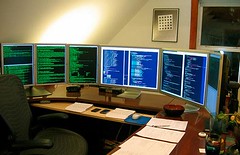Posted by Simon Long Oct 10, 2011
My Last Year = Desktop, Desktop, Desktop
I'm pretty sure all of you know I work for VMware's PSO. But did you know that for about the past year I've been specializing in VDI, specifically View? Probably not. Not a lot of people know that! I didn't know that people didn't know that, until recently at a few vBeers events I've been telling people what I've been getting up to and everyone was quite surprised. So I thought I'd share some of my experiences with you.
The two main types of engagements I've been working on are View Plan and Design and VDI Troubleshooting/Healthchecks. All of the engagements mentioned are 1000+ seat environments, all large scale and some global.
Plan and Design engagements are as you would expect… "Design a View environment to suit the requirements on the customer." To do this properly it requires a little more than just a vSphere design with View strapped to it's back. In my eyes the most important part of the Plan and Design process is the assessment phase.
During the assessment phase, detailed analysis is performed on the existing physical desktop estate. Why? Well if you don't know what processes are being performed on the physical desktops how will you know how to design an environment to cater for those processes? You might as well start pissing into the wind. The assessment is also often where you uncover possible show stoppers for VDI. Not all environments can take advantage of virtual desktops for a variety of reasons. Without performing an assessment these issues aren't often identified until the environment has been designed and implemented and by then it's too late to turn back. One other critical use of the assessment phase is to identify the base image size – how much vCPU/RAM/IOPS will your virtual desktops require. This information is critical in the design phase of the project. If you don't know the sizing of the desktops how do you know your infrastructure will have the resources to support all of the desktops? You won't! So you'll either grossly oversize your environment to cover your ass or the performance/user experience will suffer due to over contention/lack of resource.
Which brings me nicely onto VDI Troubleshooting/Healthchecks. I've been drafted in on a couple of occasions by customers who are experiencing a poor user experience on their virtual desktop environment. (Before I continue I would like to add that not all of my Troubleshooting/Healthchecks have been on VDI platforms using VMware View.) I split these engagements into two phases. During phase one, I analyze both the vSphere environment and the View components (If View is used) to ensure there isn't any misconfiguration which could lead to performance problems. Phase two is the analyzing of performance data exported from vCenter, ESXTOP and any other third party tools that might be needed (depending on the environment). I am specifically looking for obvious bottlenecks which can cause performance degridation.The main focus of my analysis is primarily ESXTOP data, although the vCenter performance graphs are a little easier on the eye.
CPU or Storage issues tend to be the biggest culprit for poor VDI user experience. For example, High CPU WAIT times often indicate resource saturation on the host caused by over contention. Reducing the VM's/Core ratio could help lower CPU WAIT values. It could also indicate CPU WAIT values are high due to poor storage performance. If the storage array cannot read/write I/O commands efficiently, the CPU will have to wait for IOPS to return from the array before it can continue processing. Poor performing storage is the biggest contributing factor in a poor performing VDI environment. If your array isn't sized to cope with the amount of IOPS that your virtual desktops are reading/writing then pain is inevitable. So how do you size your array correctly? Perform an assessment on the physical desktop environment to see what processes are being performed………….
As you can see we have come full circle.
Summary
If you do your due diligence before jumping in at the deep-end, you'll have more chance of a successful virtual desktop experience.
(Your thoughts are encouraged, please use the comments section below.)

